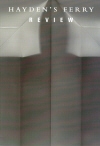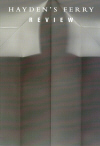Hayden’s Ferry Review – Fall/Winter 2013
 Printed on the back cover of this issue of Hayden’s Ferry Review appears, along with front and back cover art by Carlos Jiménez Cahua, the word “DEPARTURE” broken into three lines: DEP / ART / URE, and I noticed this one afternoon picking up the issue from the coffee table. I had already become somewhat familiar with the contents of the issue, and my brain reversed the fragments of the word, reading from the bottom up: Your Art Dep(artment).
Printed on the back cover of this issue of Hayden’s Ferry Review appears, along with front and back cover art by Carlos Jiménez Cahua, the word “DEPARTURE” broken into three lines: DEP / ART / URE, and I noticed this one afternoon picking up the issue from the coffee table. I had already become somewhat familiar with the contents of the issue, and my brain reversed the fragments of the word, reading from the bottom up: Your Art Dep(artment).
Printed on the back cover of this issue of Hayden’s Ferry Review appears, along with front and back cover art by Carlos Jiménez Cahua, the word “DEPARTURE” broken into three lines: DEP / ART / URE, and I noticed this one afternoon picking up the issue from the coffee table. I had already become somewhat familiar with the contents of the issue, and my brain reversed the fragments of the word, reading from the bottom up: Your Art Dep(artment).
I thought, “How appropriately mistitled. This issue is like visiting an art museum.” The more I investigated the journal, the more like a museum I found it, discovering unexpected rooms and exhibitions following each turn of the page. But I refined my initial simile: Exploring the issue is like visiting several art museums in several different countries.
For one thing, it is full of visual art, with roughly 30 pages of imagery from eight artists—primarily photography, manipulated photography, folded paper, and drawings with pen and pigment in a range of graphics. The realistic photography, however, represents the international feel of the issue, with photographs portraying couples comprising “Natives and Expats” in Thailand, Mexico, and Nicaragua; winter-wasted trailers in rural North Dakota; and a series of transit passengers by Argentine activist Soledad Manrique from “Tren de Mañana.”
The written content is as visual and often as visceral. The shape of Chelsea Biondolillo’s “Phrenology: An Attempt,” for example, combines elements of memoir, poetry, lists, and research in a page layout composed of sectioned prose, pullout boxes, and footnotes. “Phrenology” is a wonder indicative of the issue’s contents in general: defying easy classification, it’s a collage of art forms. On the first read-through, I thought it must be a visually broken, narrative poem, but with citations and memoir elements, I was relieved to read in the contributor notes later that Biondolillo writes nonfiction and journalism. Returning to the piece with the idea that it was a hybrid type of lyric essay made a lot of sense. Returning to the table of contents also confirmed its classification as nonfiction. But it challenged my perception in the ways great writing and great art do.
The Table of Contents is integral if you’re a classifier, for many other pieces also read like hybrid forms. Michael Malan’s three microfictions I first took for prose poems. They have that lyric perspective and punch we expect from poetry. “Fieldwork IV” by Leslie Morris reads like and appears as a letter written from the author—it’s signed “Sincerely, Leslie Morris”—to a Professor Keyes in Indonesia. I thought “a letter format, this must be memoir?” But according to the Contents, it’s a poem! Delightful for a contrary genre-jumper like I am. Going deeper and deeper into the issue is like opening subsequent levels to a puzzle.
In many ways, the Table of Contents is elucidating, but with a full quarter of the issue work in translation, these 50-plus pages of creative writing aren’t identified by genre, though several do appear alongside their Thai, Korean, and Arabic language originals. Other translations and contributions come from writers as disparate as their homelands, representing Ireland, Russia, Palestine, Poland, Angola, Spain, and the Americas. An editorial touch I appreciated with most of the translated material was an additional note or comment on the act of translation, as thoughtfully conveyed by Kathleen Heil’s “To Write As Though Pron Were Writing” in introduction to Patricio Pron’s translated story “Haircut,” perhaps my favorite piece in the issue.
But choosing a favorite work isn’t the point of visiting a modern art museum or, in this case, reading a literary journal. You visit for the variety. You go for the surprise exhibition and for the introduction to previously unknown artists. And with the right curators—here the astute editors of Hayden’s Ferry Review—you’ll not only walk away feeling enlightened and stimulated, but also feeling better educated, entertained, more fully formed, and well-traveled.
[www.haydensferryreview.org]





